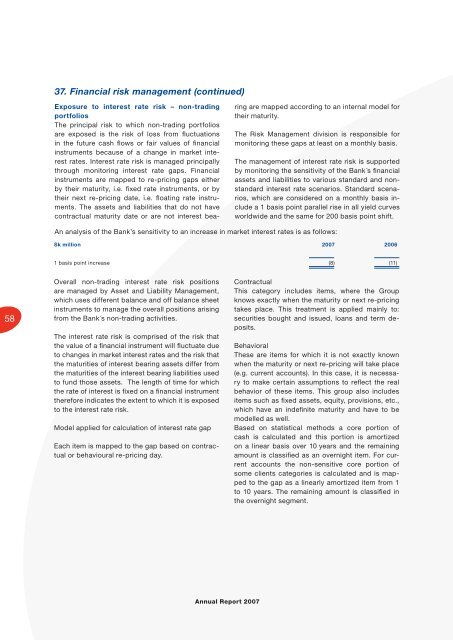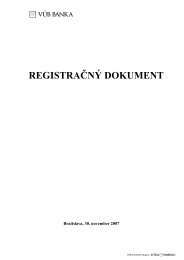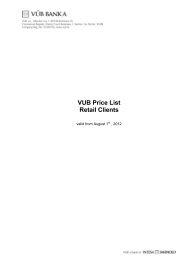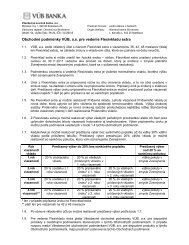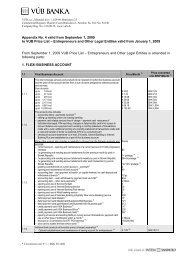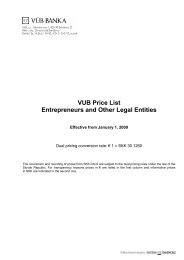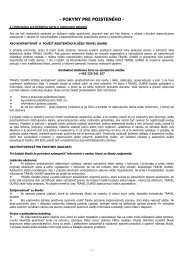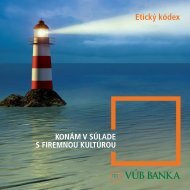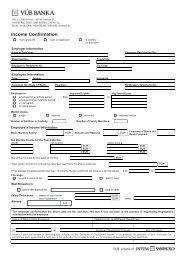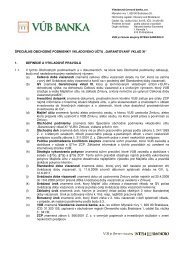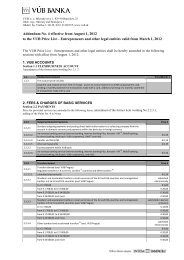Annual Report - VÃB banka
Annual Report - VÃB banka
Annual Report - VÃB banka
Create successful ePaper yourself
Turn your PDF publications into a flip-book with our unique Google optimized e-Paper software.
37. Financial risk management (continued)<br />
Exposure to interest rate risk – non-trading<br />
portfolios<br />
The principal risk to which non-trading portfolios<br />
are exposed is the risk of loss from fl uctuations<br />
in the future cash fl ows or fair values of fi nancial<br />
instruments because of a change in market interest<br />
rates. Interest rate risk is managed principally<br />
through monitoring interest rate gaps. Financial<br />
instruments are mapped to re-pricing gaps either<br />
by their maturity, i.e. fi xed rate instruments, or by<br />
their next re-pricing date, i.e. fl oating rate instruments.<br />
The assets and liabilities that do not have<br />
contractual maturity date or are not interest bearing<br />
are mapped according to an internal model for<br />
their maturity.<br />
The Risk Management division is responsible for<br />
monitoring these gaps at least on a monthly basis.<br />
The management of interest rate risk is supported<br />
by monitoring the sensitivity of the Bank´s fi nancial<br />
assets and liabilities to various standard and nonstandard<br />
interest rate scenarios. Standard scenarios,<br />
which are considered on a monthly basis include<br />
a 1 basis point parallel rise in all yield curves<br />
worldwide and the same for 200 basis point shift.<br />
An analysis of the Bank’s sensitivity to an increase in market interest rates is as follows:<br />
Sk million 2007 2006<br />
1 basis point increase (8) (11)<br />
58<br />
Overall non-trading interest rate risk positions<br />
are managed by Asset and Liability Management,<br />
which uses different balance and off balance sheet<br />
instruments to manage the overall positions arising<br />
from the Bank´s non-trading activities.<br />
The interest rate risk is comprised of the risk that<br />
the value of a fi nancial instrument will fl uctuate due<br />
to changes in market interest rates and the risk that<br />
the maturities of interest bearing assets differ from<br />
the maturities of the interest bearing liabilities used<br />
to fund those assets. The length of time for which<br />
the rate of interest is fi xed on a fi nancial instrument<br />
therefore indicates the extent to which it is exposed<br />
to the interest rate risk.<br />
Model applied for calculation of interest rate gap<br />
Each item is mapped to the gap based on contractual<br />
or behavioural re-pricing day.<br />
Contractual<br />
This category includes items, where the Group<br />
knows exactly when the maturity or next re-pricing<br />
takes place. This treatment is applied mainly to:<br />
securities bought and issued, loans and term deposits.<br />
Behavioral<br />
These are items for which it is not exactly known<br />
when the maturity or next re-pricing will take place<br />
(e.g. current accounts). In this case, it is necessary<br />
to make certain assumptions to refl ect the real<br />
behavior of these items. This group also includes<br />
items such as fi xed assets, equity, provisions, etc.,<br />
which have an indefi nite maturity and have to be<br />
modelled as well.<br />
Based on statistical methods a core portion of<br />
cash is calculated and this portion is amortized<br />
on a linear basis over 10 years and the remaining<br />
amount is classifi ed as an overnight item. For current<br />
accounts the non-sensitive core portion of<br />
some clients categories is calculated and is mapped<br />
to the gap as a linearly amortized item from 1<br />
to 10 years. The remaining amount is classifi ed in<br />
the overnight segment.<br />
<strong>Annual</strong> <strong>Report</strong> 2007


